There was a time when a car was simply a mechanical machine—engines, gears, wheels, and fuel. But today, when you step into a vehicle, you’re more likely stepping into a computer on wheels. From self-driving capabilities to over-the-air updates, the automobile industry is undergoing a silent revolution—one that’s powered by software, not steel.
The Shift: From Hardware to Software
Not long ago, innovation in the car world was all about horsepower and torque. Today, it’s about processors and algorithms. This transition didn’t happen overnight. It started quietly—with the introduction of Electronic Control Units (ECUs) in the late 1990s, designed to manage everything from fuel injection to braking.
Fast forward to today, the average car has over 100 million lines of code—more than a modern jet. Companies are now hiring more software engineers than mechanical designers, and the race is no longer about building better engines but about writing better code.
What’s Driving This Software-Centric Revolution?
- Consumer Expectations
Drivers want more than just transportation—they want an experience. Touchscreen infotainment, voice assistants, and seamless smartphone integration have made vehicles an extension of our digital lives. - Connectivity
With 4G and now 5G capabilities, cars are no longer isolated machines. They’re connected devices that talk to the cloud, to each other, and even to infrastructure. Navigation, traffic updates, music streaming—all powered by software. - Autonomous Technology
Companies like Tesla, Waymo, and even traditional players like Ford and BMW are investing heavily in autonomous driving. At the heart of it? AI and software. Sensors feed data to algorithms that make split-second driving decisions—a feat no mechanical system alone can manage. - Regulations and Safety
Safety features like automatic emergency braking, lane-keeping assist, and adaptive cruise control are all software-driven. Governments are mandating more tech-enabled safety, nudging automakers to evolve. - Over-the-Air (OTA) Updates
Just like your phone gets updates, modern cars do too. Tesla led the way, but now many brands offer OTA updates, enabling new features, bug fixes, and even performance boosts—no mechanic required.
Winners and Losers: The Industry Shake-Up
The software shift is disrupting the automotive hierarchy. Traditional manufacturers are scrambling to keep pace with tech-first companies. Tesla’s meteoric rise isn’t because of superior build quality—it’s because of its mastery in software.
Tech companies like Apple and Google are developing car platforms and infotainment ecosystems. Even Amazon is in the race, investing in autonomous startups and building voice-integrated driving experiences.
Meanwhile, legacy carmakers are acquiring software startups, opening innovation labs, and rethinking their entire development pipelines.
The Role of AI and Machine Learning
Software in cars isn’t just static—it learns. Adaptive cruise control, driver monitoring, and predictive maintenance rely on machine learning. Your car may soon know when it’s going to break down—before you do.
Advanced driver assistance systems (ADAS) use AI to analyze the road, detect obstacles, and even read traffic signs. These systems are becoming smarter over time, trained on millions of miles of data.
Challenges in the Software-First Era
- Cybersecurity Threats
More software means more vulnerabilities. Hackers can potentially gain access to vehicle systems, posing risks to privacy and safety. - Complexity
Modern vehicles are incredibly complex. Ensuring all software components work together seamlessly is a mammoth task. - Skills Gap
Automakers need software talent—but many are competing with tech giants for the same engineers. Bridging this talent gap is a challenge. - Software Reliability
Unlike phones, a car glitch can have life-threatening consequences. Software needs to be fail-safe, tested, and regulated rigorously.
The Road Ahead: What Can We Expect?
In the next five years, the average car will evolve faster than it has in the past fifty. Expect:
- Personalized driving experiences using cloud profiles.
- Voice assistants that control everything from windows to climate.
- Predictive diagnostics that reduce maintenance costs.
- Seamless integration with smart cities and infrastructure.
The industry is moving towards Software-Defined Vehicles (SDVs), where the majority of vehicle functions are controlled or enhanced by software. Updates won’t just fix bugs—they’ll unlock entirely new capabilities.
Conclusion: Reimagining What a Car Can Be
The automobile is no longer just a machine—it’s a platform. One where innovation is measured in lines of code, where engineers are debugging as often as they’re designing. As software continues to dominate, the very definition of a car is being rewritten.
Soon, asking “How fast is your car?” may be replaced by “What version are you running?”



